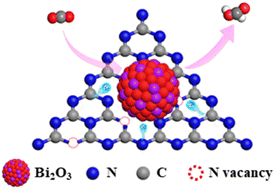Creating an electron-rich region on ultrafine Bi2O3 nanoparticles to boost the electrochemical carbon dioxide reduction to formate†
Abstract
Various metal–support composites have been reported for the electrochemical CO2 reduction reaction (ECRR), while the effect of synergy between the size effect and interface regulation on ECRR performance is still rarely explored. Herein, we report ultrafine Bi2O3 nanoparticles (∼1.9 nm) decorated on a nitrogen-vacancy-rich graphitic carbon nitride (Bi2O3/NV-C3N4) electrocatalyst for highly efficient ECRR to formate. The Bi2O3/NV-C3N4 electrocatalyst can achieve 95% formate selectivity at −0.9 V vs. RHE and 24 h long-term stability. Moreover, substantial formate selectivity (>80%) was gained over a wide potential range of more than 700 mV. The excellent performance was attributed to the electron transfer from NVs to Bi2O3, forming an electron-rich region on Bi2O3 and accelerating the electron transfer from Bi2O3 to the adsorbed intermediates. This work provides a strategy for enhancing the catalytic activity of bismuth oxides to achieve a high efficiency for CO2 reduction to generate liquid products.

- This article is part of the themed collections: Sustainable Energy & Fuels Recent HOT Articles and Sustainable Energy & Fuels Emerging Investigators Series


 Please wait while we load your content...
Please wait while we load your content...